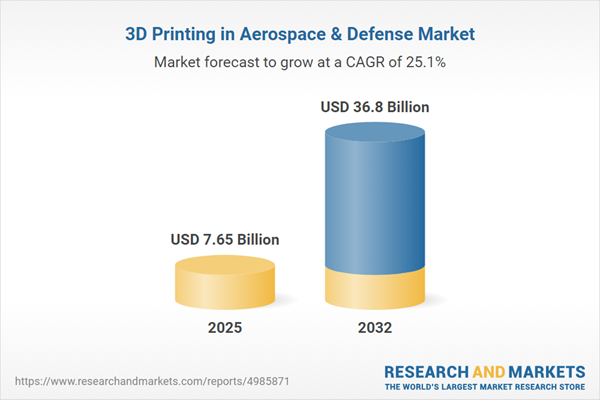Speak directly to the analyst to clarify any post sales queries you may have.
The 3D Printing in Aerospace & Defense Market is rapidly advancing, fueled by technological innovation and evolving supply chain strategies. Senior decision-makers are navigating a landscape where additive manufacturing transforms design, production, and lifecycle management, shaping the sector’s competitive future.
Market Snapshot: 3D Printing in Aerospace & Defense Market
The 3D Printing in Aerospace & Defense Market grew from USD 6.13 billion in 2024 to USD 7.65 billion in 2025. It is expected to maintain robust growth at a CAGR of 25.09%, reaching USD 36.80 billion by 2032. This momentum reflects increasing adoption by OEMs and suppliers seeking process efficiency, improved component performance, and fine-tuned production cycles. Strategic investments in both hardware and advanced materials are reshaping procurement, manufacturing, and maintenance approaches.
Scope & Segmentation of the Market
The market analysis covers a wide spectrum of technologies, materials, and services integral to modern aerospace and defense applications. This research addresses global adoption trends, segment performance, and leading corporate strategies across all stages of the additive value chain.
- Technology: Binder jetting (metal and sand), Directed energy deposition (electron beam and laser), Material extrusion (fused deposition modeling, fused filament fabrication), Powder bed fusion (electron beam and laser), Sheet lamination (laminated object manufacturing, ultrasonic additive manufacturing), Vat photopolymerization (continuous DLP, digital light processing, stereolithography).
- Material: Ceramics, Composites, Metals (aluminum, nickel, titanium alloys), Polymers.
- Service Model: In-house manufacturing, Outsourced services.
- Software: CAD/CAM solutions, Inspection and quality platforms, Simulation tools.
- Application: End-use parts (structural, nonstructural), Prototyping (concept and functional), Tooling (jigs, fixtures, molds).
- Region: Americas (including United States, Canada, Mexico, Brazil, Argentina, Chile, Colombia, Peru), Europe, Middle East & Africa (including United Kingdom, Germany, France, Russia, Italy, Spain, Netherlands, Sweden, Poland, Switzerland, United Arab Emirates, Saudi Arabia, Qatar, Turkey, Israel, South Africa, Nigeria, Egypt, Kenya), Asia-Pacific (including China, India, Japan, Australia, South Korea, Indonesia, Thailand, Malaysia, Singapore, Taiwan).
- Key Companies: 3D Systems Corporation, Stratasys Ltd., HP Inc., General Electric Company, EOS GmbH, SLM Solutions Group AG, Desktop Metal, Inc., The ExOne Company, Materialise NV, Renishaw plc.
Key Takeaways for Senior Decision-Makers
- Adoption of additive manufacturing is streamlining production workflows, supporting rapid prototyping, and enabling end-use component fabrication.
- Advanced materials and precise digital manufacturing processes are allowing for complex geometries and compliance with rigorous industry standards.
- Integration with digital twins and automated factory systems supports accelerated time-to-market and increased operational agility.
- Collaborative partnerships are advancing knowledge transfer, standardizing data protocols, and supporting robust certification for components.
- Regional market dynamics highlight domestic material production as a response to geopolitical and regulatory factors, driving supply chain resilience.
- Companies are developing hybrid manufacturing strategies that combine in-house capacity with specialized outsourcing to boost flexibility and quality control.
Tariff Impact: Navigating Cost and Sourcing Complexity
In 2025, new United States tariffs are affecting the procurement of critical materials like metal powders and advanced polymers, prompting firms to strengthen partnerships with domestic suppliers and accelerate internal material development efforts. These measures are fostering localized additive manufacturing hubs, which support both cost stabilization and supply chain continuity amid shifting policy environments.
3D Printing in Aerospace & Defense Market: Research Methodology & Data Sources
Market insights derive from a combination of primary interviews with OEMs, defense contractors, and material suppliers, supplemented by secondary sources including industry journals, technology roadmaps, financial reports, and regulatory updates. Quantitative and qualitative analyses ensure comprehensive, current, and actionable perspectives.
Why This Report Matters for Industry Leaders
- Enables strategic planning by mapping the latest technology, material, and partner dynamics essential for competitive positioning.
- Delivers actionable guidance for mitigating supply chain risks and capitalizing on domestic manufacturing opportunities.
- Supports decision-making with clarity on evolving standards, qualification pathways, and regional growth trends.
Conclusion
This report delivers targeted intelligence for capitalizing on additive manufacturing opportunities in aerospace and defense. With thorough analysis, it positions organizations to drive innovation, resilience, and sustainable growth.
Additional Product Information:
- Purchase of this report includes 1 year online access with quarterly updates.
- This report can be updated on request. Please contact our Customer Experience team using the Ask a Question widget on our website.
Table of Contents
3. Executive Summary
4. Market Overview
7. Cumulative Impact of Artificial Intelligence 2025
Companies Mentioned
The companies profiled in this 3D Printing in Aerospace & Defense market report include:- 3D Systems Corporation
- Stratasys Ltd.
- HP Inc.
- General Electric Company
- EOS GmbH
- SLM Solutions Group AG
- Desktop Metal, Inc.
- The ExOne Company
- Materialise NV
- Renishaw plc
Table Information
| Report Attribute | Details |
|---|---|
| No. of Pages | 190 |
| Published | November 2025 |
| Forecast Period | 2025 - 2032 |
| Estimated Market Value ( USD | $ 7.65 Billion |
| Forecasted Market Value ( USD | $ 36.8 Billion |
| Compound Annual Growth Rate | 25.0% |
| Regions Covered | Global |
| No. of Companies Mentioned | 11 |









